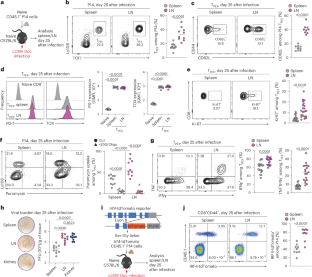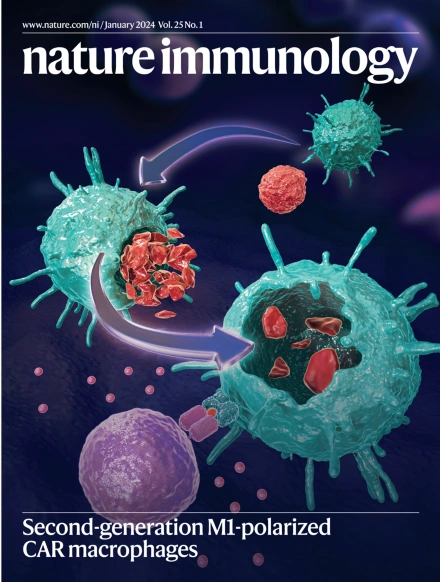Lymph nodes fuel KLF2-dependent effector CD8+ T cell differentiation during chronic infection and checkpoint blockade
IF 27.6
1区 医学
Q1 IMMUNOLOGY
引用次数: 0
Abstract
Exhausted CD8+ T (TEX) cell responses are maintained by precursors of exhausted T (TPEX) cells that possess high self-renewal and developmental potential. TPEX cells also drive the proliferative burst of effector T cells upon therapeutic immune checkpoint blockade (ICB). However, the spatial context and signals that regulate their differentiation and function are not well defined. Here we identify developmental and functional compartmentalization of TPEX and TEX cells across secondary lymphoid organs during chronic infection. We show that stem-like CD62L+ TPEX and effector-like CX3CR1+ TEX cells constitute a distinct developmental lineage that is promoted by the lymph node (LN) microenvironment and dependent on the transcription factor KLF2. LNs act as a niche in which migratory dendritic cells provide antigen and costimulatory signals to maintain the proliferative fitness of CD62L+ TPEX cells and generation of CX3CR1+ TEX cells. Moreover, LNs exclusively drive the proliferative burst and systemic dissemination of CX3CR1+ TEX cells during ICB. Thus, our findings identify a unique role for LNs in the maintenance of T cell differentiation and function during systemic chronic infection and ICB therapy. Here the authors show a function for lymph nodes in the maintenance of effector T cell differentiation and function during chronic infection and checkpoint blockade, identifying a spatial component in the regulation of exhausted T cell fitness.


慢性感染和检查点阻断期间,淋巴结燃料klf2依赖性效应CD8+ T细胞分化
耗竭的CD8+ T (TEX)细胞反应是由耗竭T (TPEX)细胞的前体维持的,这些细胞具有高度的自我更新和发育潜力。TPEX细胞也在治疗性免疫检查点阻断(ICB)时驱动效应T细胞的增殖爆发。然而,调控其分化和功能的空间背景和信号尚未得到很好的定义。在这里,我们确定了慢性感染期间TPEX和TEX细胞在次要淋巴器官中的发育和功能分区化。我们发现,干细胞样CD62L+ TPEX和效应样CX3CR1+ TEX细胞构成了一个不同的发育谱系,由淋巴结(LN)微环境促进,依赖于转录因子KLF2。ln作为一个生态位,迁移的树突状细胞在其中提供抗原和共刺激信号,以维持CD62L+ TPEX细胞的增殖适应性和CX3CR1+ TEX细胞的产生。此外,在ICB期间,LNs专门驱动CX3CR1+ TEX细胞的增殖爆发和全身播散。因此,我们的研究结果确定了在系统性慢性感染和ICB治疗期间,LNs在维持T细胞分化和功能方面的独特作用。
本文章由计算机程序翻译,如有差异,请以英文原文为准。
求助全文
约1分钟内获得全文
求助全文
来源期刊

Nature Immunology
医学-免疫学
CiteScore
40.00
自引率
2.30%
发文量
248
审稿时长
4-8 weeks
期刊介绍:
Nature Immunology is a monthly journal that publishes the highest quality research in all areas of immunology. The editorial decisions are made by a team of full-time professional editors. The journal prioritizes work that provides translational and/or fundamental insight into the workings of the immune system. It covers a wide range of topics including innate immunity and inflammation, development, immune receptors, signaling and apoptosis, antigen presentation, gene regulation and recombination, cellular and systemic immunity, vaccines, immune tolerance, autoimmunity, tumor immunology, and microbial immunopathology. In addition to publishing significant original research, Nature Immunology also includes comments, News and Views, research highlights, matters arising from readers, and reviews of the literature. The journal serves as a major conduit of top-quality information for the immunology community.
 求助内容:
求助内容: 应助结果提醒方式:
应助结果提醒方式:


